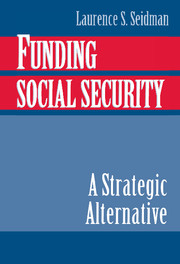Book contents
- Frontmatter
- Contents
- Acknowledgments
- 1 Funding Social Security: An Introduction
- 2 Funded versus PAYGO Social Security
- 3 Funded versus Privatized Social Security
- 4 Funded versus PAYGO Social Security with Individual Accounts
- 5 Funded versus Means-Tested Social Security
- 6 Questions and Answers
- References
- Index
3 - Funded versus Privatized Social Security
Published online by Cambridge University Press: 06 July 2010
- Frontmatter
- Contents
- Acknowledgments
- 1 Funding Social Security: An Introduction
- 2 Funded versus PAYGO Social Security
- 3 Funded versus Privatized Social Security
- 4 Funded versus PAYGO Social Security with Individual Accounts
- 5 Funded versus Means-Tested Social Security
- 6 Questions and Answers
- References
- Index
Summary
This chapter compares funded Social Security with privatized Social Security. In this book, “privatized Social Security” means a defined-contribution plan, where retirees receive benefits that depend on the accumulation in their own personal funds and where individuals possess ownership and control of their own portfolios and have the choice of whether to purchase an annuity upon retirement.
There is important common ground shared by funded and privatized Social Security. Both are likely to raise the national saving rate and capital accumulation. Both would entail investment in the stock market. Both are likely to achieve a higher yield on average than PAYGO Social Security. This common ground is emphasized in Seidman (1998a). As Auerbach (1997) writes: “Much of the current excitement about privatization stems from a misunderstanding about what it can do …. It is simple economics that the same market rate of return could be delivered by a funded public system” (p. 71).
This chapter concentrates on the differences between funded and privatized Social Security.
FERRARA'S CASE FOR PRIVATIZATION
Peter Ferrara of the Cato Institute has been a leading advocate of privatized Social Security for nearly two decades (Ferrara 1982). In a recent article (1997), he sets out his case for privatization. Most of his argument, however, is a critique of PAYGO Social Security and so provides support for funded Social Security as well as privatized Social Security.
- Type
- Chapter
- Information
- Funding Social SecurityA Strategic Alternative, pp. 83 - 122Publisher: Cambridge University PressPrint publication year: 1999



